When I went in 2018, I took a birding tour around a loop road that is closed to vehicle traffic except authorized tours. When I tried to sign up this time, I could find nothing on the Laguna Atascosa website, the Friends of Laguna Atascosa website or just the web in general. So, I called the Refuge and was told that the tours were suspended the year after I went, but that I could bicycle or walk the loop. It's hot, it's dusty, I have heavy cameras and it's 14 miles! There had to be another way!
 I called the South Padre Island Birding and Nature Center (SPIBNC), a world-renowned facility that I was also planning to visit when in South Texas, to see if they knew of any tours.
I called the South Padre Island Birding and Nature Center (SPIBNC), a world-renowned facility that I was also planning to visit when in South Texas, to see if they knew of any tours. They directed me to a company named Henry's Charters that was doing a day tour that included Laguna Atascosa and SPIBNC and was led by one of their own naturalists.
I checked it out and they had one tour two days after I had originally planned to be in South Padre. I was disappointed, but then decided to change my plans so I could do it.
That schedule change meant I had to kill time between Balcones Canyonlands and South Padre Island. At first, I was going to go to Padre Island (which also has Aplomado Falcons), but then I found out about the Santa Margarita Ranch tour that I covered in my last post.
 |
| Javier: Port Isabel South Padre Press |
So, I jiggled things around and booked a spot with Henry's.
Henry's Charters primarily does fishing charters and boat tours, along with some wildlife rescue. They had recently added bus tours, which are quite infrequent. The one I booked was the last of the year.
Our driver was Henry Rodriguez (the Henry of Henry's) and our guide was Javier Gonzalez, SPIBNC Naturalist Educator and avid birder, who does full-day tours on his days off from SPIBNC.
The seven-hour tour hosted a small group in a nice bus.
 |
| Our bus |
It included four stops: Cactus Creek Ranch, Laguna Atascosa's Steve Thompson Wildlife Drive, the South Texas EcoTourism Center and SPIBNC.
Cactus Creek Ranch
We started with a yummy breakfast and walking tour of Cactus Creek Ranch.
 |
| Breakfast |
 |
| Left: Tufted Titmouse nest; Right: Tufted Titmouse from CCR Facebook page |
Founded by owner Mary Jo Bogatto and her first husband in 1995, the 400-acre ranch was set up as a shooting center (her husband's dream) and learning center (her dream).
 |
| Our group outside the Ranch house (Mary Jo in the boots; her husband with the beard and dog) |
After her husband died, she continued to operate the ranch, focusing on the environment. After she remarried, her husband joined the operation. But, Mary Jo, a certified Master Naturalist, a junior angler instructor and a hunting and fishing guide, is definitely the heart and soul of Cactus Creek.
 |
| Texas Horned Lizard; Photo: CCR |
Since 1996, Mary Jo had planted 20,000 native plants throughout the ranch to restore plant diversity and habitat for Ocelots, Aplomado Falcons and Texas Horned Lizards.
She even builds shelters over active Ant hills to allow the Lizards to feed with being plucked off by Raptors.
She constructed ponds and wetlands that sustain plant and animals species including American Alligators and a variety of Turtles and Fish.
 |
| Our group on the opposite side of the pond |
As president of Friends of Laguna Atascosa NWR, she played a key role in the acquisition of 27,000 acres of South Padre Island for the Refuge. She raises awareness in Texas schools by hosting neighborhood school groups at the Ranch where students can learn firsthand about native plants, habitat restoration and birding. And, she created an activity book and curriculum, Conservation in the Curriculum.
 |
| On the grounds (that's me in the middle) |
She also works with a variety of organizations to conduct environmental studies, including studying Duck nesting boxes and nesting structures for Hawks and Owls.
Mary Jo led us on a walk around the property, where we saw lots of evidence of wildlife, but not as many animals as I had hoped.
 |
| The grounds |
There were lots of birds on the feeders outside her gracious Ranch house.
I have really been wanting to get a photo of some Bobwhites and, although I saw some, I was never in the right place to get a photo.
 |
| I did, however, capture a female Great-tailed Grackle |
The morning was a bit gray and very windy, which is why, I believe, the wildlife was a bit scarce.
 |
| There was a fairly large contingent of Long-billed Dowitchers feeding in a pond |
 |
| There were Black-necked Stilts |
 |
| Greater Yellowlegs and very distant Stilt Sandpipers (not shown) |
Most had stopped for some sustenance as they migrated through.
We also saw some Wild Turkeys and a smattering of birds ...
... plus some interesting insects ...
 |
| Silver Garden Orb Weaver Spider |
 |
| Pale Tiger/Banded Tussock Moth Caterpillar |
The entire dirt trail we walked along was pock-marked with holes that turned out to be dug by land Fiddler Crabs. We didn't find any to photograph (they are top prey for most of the birds and critters that frequent the ranch, so they hide during the day), but their presence was obvious.
 |
| Fiddler Crab at Cactus Creek Ranch; Photo: Clifton Albrecht |
I thoroughly enjoyed Cactus Creek Ranch, but the "good time, but not great photos" theme of my visit was still in play.
 |
| Our group; Mary Jo in the middle in snake boots; Henry bottom left |
Maybe our next stop ...
Laguna Atascosa NWR – Steve Thompson Wildlife Drive
 |
| Laguna Atascosa |
Maybe this time I would see some Aplomado Falcons.
Laguna Atascosa National Wildlife Refuge encompasses more than 120,000 acres, a portion of which are open to the public for wildlife watching, hunting, fishing, photography and environmental education.
The Refuge was established in 1946 to provide habitat for wintering waterfowl and other migratory birds, principally Redhead Ducks (80 percent of the world's Redheads winter there, but they were gone to their summer homes when I went this time). The largest population of Ocelots in the United States calls the Refuge home, making it the center for conservation and recovery efforts for this endangered cat.
 |
| We drove this loop |
In 1994, Thompson was selected as U.S. Refuge Manager of the Year from among leaders of more than 500 National Wildlife Refuges throughout the nation. He died in 2018.
The Steve Thompson Wildlife Drive passes through coastal prairie and thorny brush forest, by coastal lomas (mounds of clay that support grasses and plants), along freshwater wetlands and savannas and along the coastline of the Laguna Madre.
 |
| Water and palms |
Laguna Madre, a long, shallow, hypersaline lagoon along the western coast of the Gulf of Mexico, is one of seven major estuaries along the Texas Gulf Coast. It is approximately 130 miles long, the length of Padre Island.
The western shore is usually marked by sand dunes, yucca, prickly pear, century plants and an occasional oak tree bent by the wind.
 |
| The Laguna Madre |
The lagoon is split by a 20-mile expanse of the Saltillo Flats, which are located about 40 miles from the northern extreme in Corpus Christi. The Lower Laguna Madre, where we were, includes the area south of the Saltillo Flats to Port Isabel.
The Lagoon is shallow and narrow, averaging only 3.6 feet deep and 4 to 6 miles wide. The depth is only 1.1 feet in areas not dredged to form the Gulf Intracoastal Waterway, which runs the bay's length. Indeed, we saw fishermen standing thigh-deep in the middle of the bay.
Laguna Madre is one of the Earth's six hypersaline lagoons/bays. The others are in Ukraine, on the west coast of Baja California, in Australia and the Laguna Madre of Tamaulipas, Mexico, which is sometimes grouped with the Laguna Madre of Texas as one system.
 |
| The Laguna Madre has lots of sea grass, which you can see here |
The lagoon's hypersalinity is caused by isolation from other bodies of water, lack of a significant river source and a high rate of evaporation caused by the lagoon's shallowness and the relatively dry climate.
Our drive started in the coastal prairie, with its low scrubby plants and trees, where we spent a lot of time watching an Altamira Oriole building a nest.
 |
| They attach the nest to the end of a horizontal tree branch or telephone wires |
This beautiful bird, widespread in subtropical lowlands of the Mexican Gulf Coast, northern Central America, the Pacific coast and inland, didn't arrive in Texas until 1939. Now, they are quite common permanent residents. They nest in open woodland, building a very long woven pouch of moss, grass, palm fibers, weeds and strips of bark that they line with feathers. The nest is assumed to be built by the female, but it is not known how long it takes. Altamira Orioles lay 4-6 eggs and nestlings are fed and cared for by both parents.
The Altamira Oriole is a forage gleaner, searching for food through the tree-tops to the near-ground bottom of the tree.
Its diet includes fruit (small fruits, hackberries and figs) and insects, such as grasshoppers, crickets and caterpillars.
 |
| Sitting in one of the Refuge's taller trees |
Except for some distant Crested Caracaras, it turned out that we didn't see many other birds until we got to the shore of the Laguna Madre.
 |
| There were a number of Neotropic Cormorants and Caspian Terns |
The combination of dust, heat and some light fog made it impossible to photograph the distant seabirds, so I didn't really try.
I didn't, but we certainly saw a lot. Last time, I think we saw two or three. This time, big herds.
 |
| A large group of primarily males |
The largest antelope of Asia, Nilgai were brought to Texas from India in the 1920s and 1930s for hunting. Now, they are among the most abundant free-ranging exotic ungulate in Texas, with an estimated population of 15,000-36,000 living in south-central and southern Texas.
 |
| Males are a blueish gray and females and calves are tawny |
The majority are found in free-ranging populations on several large ranches. These are BIG animals: standing up to 57 inches at the shoulder and weighing up to 635 lbs. for bulls and 470 lbs. for cows. Only males possess horns, which are 5.9 to 9.4 inches long.
Nilgai band together in three distinct kinds of groups: one or two females with young calves, three to six adult and yearling females with calves and all-male groups with two to 18 members.
They prefer areas with short bushes and scattered trees in scrub forests and grassy plains. The Nilgai is a browser or mixed plant feeder, but primarily a grazer in Texas.
 |
| Running Nilgai |
They can survive for long periods without water and do not drink regularly even in summer.
At Laguna Atascosa, they appear to be rather timid, warily watching and then bounding away.
Perhaps this is because hunting Nilgai is allowed on the Refuge and, because they are imported, there is no season. Hunting can occur year-round. Much of the approved hunting is by bow-and-arrow.
Since you can't drive a vehicle on the road, it seems that dressing and hauling out the kill would be difficult. The meat is said to be delicious.
 |
| We also saw a Texas Tortoise |
 |
| And, a White-eyed Vireo that was too fast as it flitted around in the dense thicket; Left: eBird |
And, that brings me to our target bird, the Aplomado Falcon. Did we see them?
Yes. But, I wanted this ...
 |
| Aplomado Falcons; Photos: Left, BirdNote; Right, eBird |
... and I got this ...
 |
| At least you can see them |
Distance, heat and wind made a decent photo impossible.
 |
| The nesting box supports Aplomado Falcon reintroduction |
The Aplomado Falcon is very slender, long-winged and long-tailed, roughly the size of a small Peregrine Falcon at 12 to 16 inches long and with an average wingspan of about 36 inches. Like most raptors, females are larger than males.
 |
| Photo: Nature Admirer |
It has the usual Falcon "moustache" contrasting sharply with the throat and eyestripe.
The belly and thighs, below some black patches, are cinnamon. The black tail has narrow white or grey bars and a white tip.
The cere, eye-ring and feet are yellow or yellow-orange.
 |
| Aplomado range |
Its habitat is dry grasslands, savannas and marshes. It feeds on large invertebrates and small vertebrates, with small birds making up the overwhelming bulk of its prey. A bird primarily of South America, the range spreads slightly into Texas where it was resident until
the 1950s. Reintroduction efforts, using falconry birds, have brought it back in small numbers.
The Aplomado is closely related to the Merlin and the American Kestrel.
In my original plan, I was also planning to go to Mustang Island near Padre Island, but I changed that so that I could do the Santa Margarita Ranch tour. Maybe I should have expanded for a few more days to try to see an Aplomado. Oh, well ...
South Texas EcoTourism Center
Our next stop, the South Texas EcoTourism Center (STEC) in Laguna Vista, which was intended to be another chance to see Aplomado Falcons. There were none there. There were, however, other birds.
Only a year old, STEC includes ten acres of land; indoor and outdoor classrooms; exhibit and event space; a to-be-built "water lab" for training water plant operators and for testing water samples locally instead of sending them elsewhere; bird blinds; and a large elevated boardwalk.
 |
| Heading out on the boardwalk |
From a distance it looks almost like an amusement park.
 |
| Main photo: X.com |
At the top of the boardwalk, we witnessed Western Willets flying rapidly by in a courting ritual and saw a couple of Gull-billed Terns, but, it was fairly quiet.
 |
| It looks like they need to continue construction to attract a higher volume of birds |
We did see ...
 |
| Great-tailed Grackles |
 |
| Eastern Meadowlarks |
 |
| A Greater Yellowlegs |
 |
| And a Stilt Sandpiper with an injured leg hanging out with a tiny Least Sandpiper |
South Padre Island Birding and Nature Center
Our last stop was back over the bridge to the SPIBNC, where we had two things going for us: the weather improved just a smidge giving us blue sky and the SPIBNC's extensive boardwalk system gave us closer access to some pretty birds.
 |
| SPIBNC; Photo: Paul Webb |
South Padre Island is a very popular birding spot because it is a first landfall after birds make the arduous cross-Gulf migration from Southern Mexico and northern Central America. Tired birds land in South Padre to rest and fatten up before continuing north.
During migration – and especially after a spring storm – the Island can teem with Warblers, Tanagers, Orioles and Thrushes.
At the southern tip of the world's longest barrier island, the 50-acre SPIBNC presents a microcosm of the rich habitats that contribute to South Padre: dune meadows, salt marsh, intertidal flats, mangroves and thickets of native shrubs and trees.
 |
| Wetlands harbor a range of shorebirds and waterfowl |
We started our visit by catching the very end of the daily Alligator talk, which they hold three times every day (they also have a daily Snake talk).
 |
| SPIBNC Alligator show |
SPIBNC is a habitat of wild Gators and serves in a relatively new role as an Alligator Sanctuary. It has 50 Alligators that have been rescued from ponds, pools, piers and other situations where they had become a nuisance. Once most reach six feet in length (breeding size), they are transferred to Gator Country in Beaumont, Texas. However, the SPIBNC has two original resident Alligators: Big Padre at 12' 7" and 750 lbs. and Lady Laguna at 7' 6" and 200 lbs.
We walked the boardwalks and saw quite a few beautiful birds, including ...
 |
| Neotropic Cormorants |
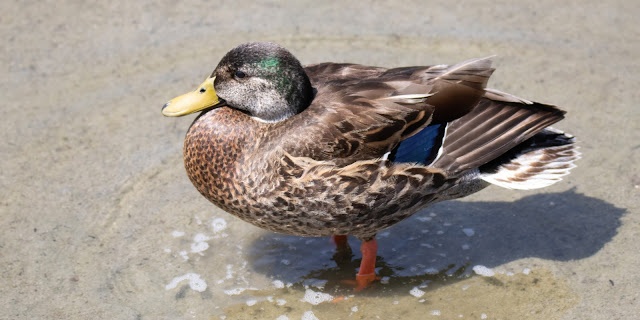 |
| A hybrid Mallard that was most likely part Mexican Duck and maybe part Mottled Duck |
 |
| A large number of Black-bellied Whistling Ducks |
 |
| Blue-winged Teals |
 |
| Great Egrets |
 |
| Lots and lots of Laughing Gulls, flying ... |
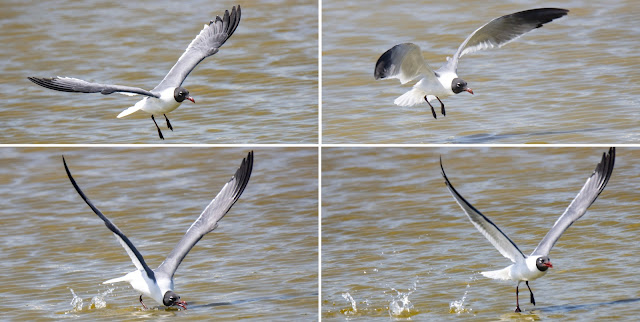 |
| ... and fishing |
 |
| Two absolutely gorgeous Tricolored Herons in breeding plumage |
I had no idea Tricolored Herons could get prettier than ones I had seen before (mainly in Florida). But, these had brilliant periwinkle blue bills.
The Herons were demonstrating one reason birds hang around so close to the boardwalk: to hunt.
 |
| Hunting Tricolored Herons |
The water is absolutely teeming with fish.
The Tricolored Herons seemed to favor the small-to-medium ones.
But, we also saw some fairly large Mullet swimming by.
 |
| Swimming under the boardwalk |
Around the corner, we encountered two juvenile Roseate Spoonbills. Javier told us that it was easy to tell that they were juveniles because they had feathers on their heads. Adults are bald.
Like the American Flamingo, their pink color is diet-derived, consisting of the carotenoid pigment canthaxanthin (the pink you see in Shrimp). The colors can range from pale pink to bright magenta, depending on age, whether breeding or not and location.
 |
| Great Blue Heron |
Right next to the Spoonbills was a Great Blue Heron, standing stock-still in the water. The largest Heron native to North America and the third-largest in the world, the Great Blue Heron is 3 to 4.5 feet tall and has a wingspan of 5.5 to 6.5 feet.
Great Blue Herons can be is found throughout most of North America, as far north as Alaska and the southern Canadian provinces in the summer.
In winter, the range extends south through Florida, Mexico and the Caribbean to far northwestern South America.
Birds east of the Rocky Mountains in the northern part of their range are migratory and winter in the coastal areas of the southern United States, Central America or northern South America. From the southern United States southwards and on the lower Pacific coast, they are year-round residents. However, their hardiness is such that individuals often remain through cold northern winters, as long as fish-bearing waters remain unfrozen (which is usually the case only in flowing water such as streams, creeks and rivers).
 |
| Blending in |
I couldn't find any (but, because they are so camouflaged, one could have been right in front of me).
I did, however, see a Green Heron that was well-hidden against the tall reeds. It's amazing how much you can miss if you don't look closely.
I also photographed a lovely Mangrove Yellow Warbler in the (you guessed it) mangroves.
 |
| Mangrove Yellow Warbler |
While not counted as a separate species of Yellow Warbler, this bird looks completely different with its ruddy chestnut head.
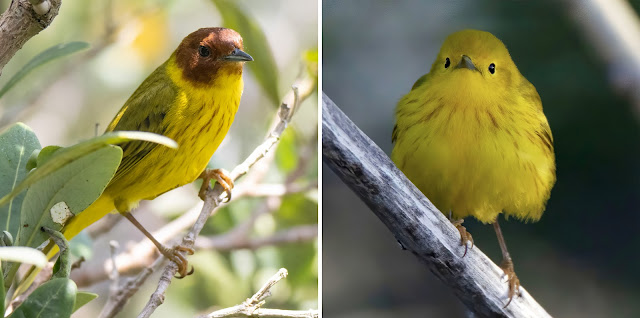 |
| Left: Mangrove Yellow Warbler; Right: Yellow Warbler |
This pretty bird is found along the east and west coasts of Central America and the northern coast of South America plus a few very small areas of the far southern U.S. Seeing this cutie – up close – was a big treat.
Walking along the boardwalk and shooting photos of birds was a pleasant way to end a lovely day.
 |
| Spring in South Texas |
I did see the Aplomado Falcons and a lot of pretty birds, but I was still itching to get more. We'll talk about that next.
Trip date: April 7-17, 2024












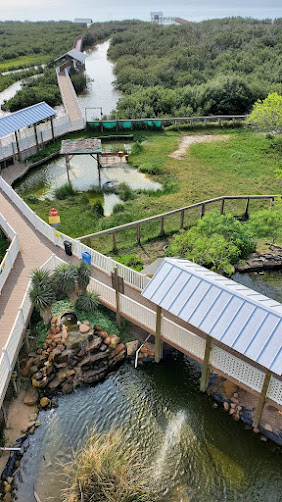

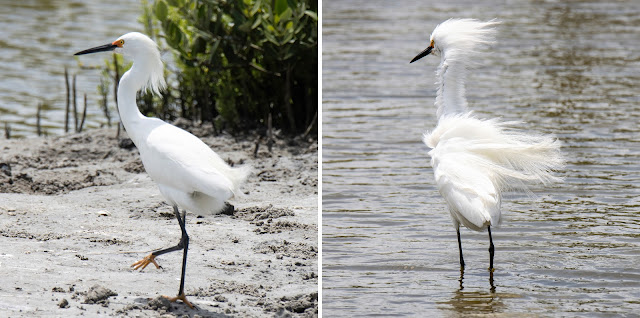


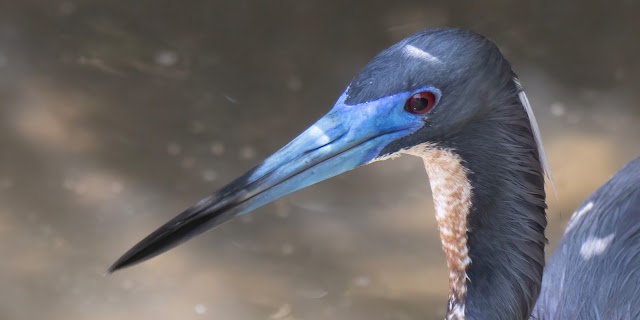

No comments:
Post a Comment